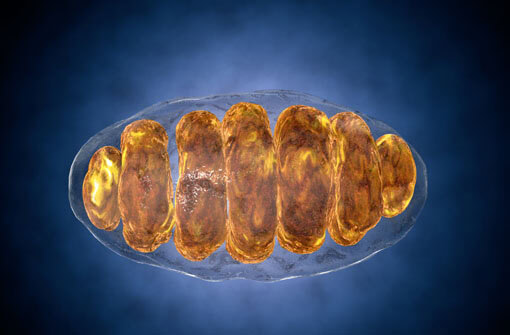Mitochondrial Therapy
The metabolic regulation of mitochondria
Not only the intestinal environment is essential for our health. Just as important is the condition of our energy power plants in the cells – our mitochondria. Only healthy mitochondria can provide us with sufficient energy!
And just like our intestinal microbiome, the mitochondria also react sensitively to stress. An unhealthy lifestyle and harmful environmental factors both have a long-term impact – with consequences for the entire organism.
Damaged mitochondria can cause silent inflammations in the body, which are the basis for chronic diseases. It comes to a vicious circle, which fortunately can be broken.
The aim of mitochondrial therapy is to reduce inflammatory processes, strengthen the immune system and thus enable the restoration of healthy metabolic processes.
What is the reason for the increasing weakness of the mitochondria?
1. Increasing deficiency of vital substances in soils and food
Unfortunately our food is no longer as rich in vitamins as in the days of our grandparents. Especially since the 70s, the content of vital substances in vegetables and fruit has decreased considerably.
Our soils can no longer recover, become poorer in nutrients and contaminated with chemical fertilizers and pesticides. In addition, the fruit is usually harvested unripe, resulting in long transport and storage times, UV radiation etc.
2. Sharp increase in environmental pollution
These include, for example, pollutants in the air, electromagnetic fields (electro-smog), the frequent use of medication and toxin contamination through vaccinations and dental materials. But a stressful lifestyle that does not include enough relaxation phases also belongs in this category!
Since, according to recent findings, mitochondria are very probably of bacterial origin, antibiotic treatments in particular have a devastating effect on their condition!
How does exhaustion of the mitochondria manifest itself?
The reduction in the activity of the mitochondria usually begins gradually and therefore it is often ignored for a long time that the mental and physical functions slowly but steadily decline.
The following signs may indicate a weakening of the mitochondria:
- Tiredness and exhaustion
- Craving for sweets, symptoms of hypoglycemia
- Digestive disorders (flatulence, heartburn, winds, diarrhoea)
- Decrease in the ability to concentrate and memory, word finding disorders
- Changing muscle, spine and joint pain
- Increasing irritability, noise sensitivity
- Sensitivity to bright light, air draft and air conditioning
- Late bedtime, insomnia
- First meal is always taken later
- Headache or migraine
- High sensitivity to any kind of stress
How does the metabolic regulation of the mitochondria take place?
The Trikombin technology, which can also work in the megahertz range, has given us the possibility to test and treat in the intracellular space.
With the help of a special test arrangement bioenergetic tests are carried out:
- What is the value of mitochondrial weakness? (Measurement of mitochondrial activity)
- Which blockages underlie the weakness of mitochondria (e.g. disruption of sugar metabolism, lack of co-factors for the citrate cycle and ATP formation, fatty acid degradation weakness due to carnitine deficiency, fructose load, chronic oxidative stress and gluthation deficiency, nitrosative stress and oxygen radicals)
- Which food supplements are needed for support (Measurement of needs)
Requirements for the success of the therapy
For a sustained success of the metabolic regulation of the mitochondria, it is of course not sufficient to simply take the many tested preparations.In addition, the following points should also be observed in any case:
- Ensure sufficient daily exercise (preferably in fresh air)
- Drinking of pure water
- Stress reduction
- As far as possible: avoidance of medicines, chemicals, toxins and electromagnetic fields
- Fresh, alkaline-rich nutrition from organic farming
- Reduction of carbohydrates, strict elimination of pork
- Activation of the excretion and detoxification pathways
Treatment of autoimmune diseases in practice
Of course, we cannot influence any genetic predisposition. But we can take effective action against all other probable causes:
- Since approximately 80% of the immune system is located in the gut, improving gut health is an important prerequisite for healing.
- Experience shows that a key factor for success is detoxification and therapy of the thymus gland so that it can once again perform its role in the maturation of T cells without restriction.
- The allergy to certain pathogens must be treated and, in addition, the pathogens must be decoupled from the affected organ.
- Last but not least, it is essential to eliminate as many physical and psychological stress factors as possible. In practice, we can treat physical stressors (allergies, heavy metals, environmental toxins); however, it is just as important that you address psychological stress triggers (e.g., sleep patterns, nutrition, exposure to electromagnetic fields, lack of grounding, learning relaxation techniques, etc.).
The treatment of autoimmune diseases is therefore a lengthy process that definitely requires your cooperation.
But it is a very worthwhile treatment, because without eliminating the negative conditions (especially in the intestines and thymus gland) and supporting the affected organs, the immune system is unable to regenerate itself.

